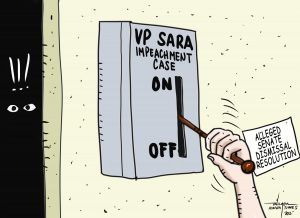Maybe all schools in the country and a good number of establishments have never failed to join earthquake drills at the behest of authorities. But how often do these exercises occur and how serious are the students and other participants? At most, they take place twice a year.
That’s no way to instill a safety consciousness in an archipelago that lies along several fault lines. The tokenism pales in comparison to Japan’s practice of regularly holding drills some of which simulate worst-case scenarios like a 7.2-magnitude tremor hitting Tokyo, the nation’s capital. Now, that has nothing to do with Japan’s economic status; the issue here is instilling in the citizens a “safety first” culture.
That we lag far behind in safety consciousness shows in the unwillingness of many Filipinos to follow traffic rules. Many still dislike using seat belts, helmets (in the case of bike riders), overpasses and pedestrian lanes. The same holds true during storms and heavy rains; many would resist orders to evacuate citing as reason the need to guard their homes from opportunists.
Back to earthquake preparedness, it’s worth asking if government is already contemplating setting standards to make houses and other structures withstand temblors up to a certain magnitude. This is particularly needed in Metro Manila, Cebu, Davao and other highly urbanized, densely populated areas. High-rise buildings, for example, must be required to adopt earthquake-proof technologies. And while the prevalence of graft among regulatory agencies may frustrate attempts to realize this, it’s worth the effort nonetheless.
In addition, individual households must be encouraged to prepare earthquake survival kits that include first aid materials, food, water and flashlights or torches. These items must be made available in major stores.
Duck, cover and hold. These are important things to remember during earthquakes. But more needs to be done.



